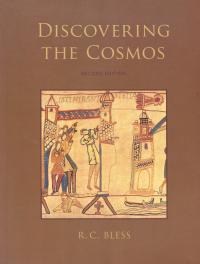Discovering the Cosmos
Discovering the Cosmos
By: R.C. Bless
This book provides a rich, historical approach to introductory astronomy. It is ideal for use in an introductory astronomy course for nonmajors.
For all sales outside of the United States, please contact Felicity Henson, fhenson@aip.org
Title information
Based on the very popular liberal arts course Bob Bless has taught at University of Wisconsin for many years, this book provides a rich, historical approach to introductory astronomy. It is ideal for use in an introductory astronomy course for nonmajors. In the fifteen years since the first edition of this text was published, several new concepts such as dark matter, dark energy, and an incredible expansion of the universe (inflation) have been developed. Furthermore, many of the exotic effects predicted by General Relativity (e.g. black holes, warped space) have gone from being interesting theoretical speculations to useful practical tools for understanding the universe. This book aims to give an overview of astronomy, but in such a way that the non-science major can get a feeling for how science actually developed with its false starts and wrong turns, which observational evidence eventually corrected, and also to describe the incredible recent developments in our understanding of the physical universe. Several chapters of this 2nd edition have been extensively revised to include these recent developments.
Because it has become increasingly difficult to “cover” all of astronomy in a one-semester course, this edition has largely omitted coverage of the physical nature of the objects in our, and other, planetary systems, although a discussion of the possibility of life elsewhere closes the book.
1. Comments to the Reader
PART I: Cosmology From the Beginnings through Newton
2. The Naked-Eye Sky
3. Early Greek Astronomy
4. The Beginnings of Quantitative Astronomy
5. The New Astronomy
6. Newtonian Synthesis
PART II: The Tools of the Astronomer
7. Tools of the Astronomer — Physical Concepts
8. Tools of the Astronomer — Hardware
PART III: The Life and Death of Stars
9. Reading Stellar Spectra
10. The Hertzsprung-Russell Diagram
11. The Structure of Stars
12. The Interstellar Medium — Birthplace of the Stars
13. Stellar Evolution — The Early Phases
14. The Late Phases of Stellar Evolution — Degenerate Corpses
15. Black Holes
Part IV: Cosmology from Herschel to the Present
16. The Discovery of Galaxies
17. The University of Galaxies
18. Active Galaxies
19. The FIrst Cosmological Clues
20. Models of the Universe
21. The Mysterious Universe
Epilogue
22. Life Elsewhere: Are We Alone?
Appendices
Index
|
From Reviews of the First Edition “I was completely delighted with Bob Bless’s new book. It strongly addressed the two most serious needs I perceive in the standard menu of introductory astronomy texts: a better treatment of history and more use of mathematics.” “The text is an excellent synthesis of an enormous topic that is presented in a clear, very readable fashion and provides interesting reading along the way.” “If you know your way around the sky, then Bob Bless’s entertaining exposition of the nuts and bolts behind the scenes should add an extra dimension to your observations; if you don’t, like me, then here is an incentive to get outside, tonight, and have a look.” “This is a very solid astronomy text for undergraduate students. It is a scholarly introduction to a popular science elective. Its depth, rigor and accuracy make it the 1990 successor to the famous 60s and 70s texts of George Abell…The materials on the history of astronomy are the best I have seen in any textbook on astronomy.” “An extremely well-written text. All of astronomy is presented here, in a comprehensive and up-to-date text. The art is excellent, and the text is uniformly well-written. The combination of a significant quantitative content and a liberal arts perspective makes it ideal.” From Reviews of the Second Edition “Astronomy is a big subject, spanning the multi-billion light-year extent of the cosmos, and the entirety of human history. It’s no easy task to encapsulate all this in a single text. The new edition of Bob Bless’s book provides the best all-around treatment of the subject that I’ve found at the undergraduate level, including a thorough yet concise survey of astronomy’s rich history, as well as rigorous but accessible explanations of diverse astrophysical phenomena. It’s an admirable achievement.” “This is an excellent book. It is also different. It offers a clear alternative choice over its competitors.” “This new edition of Discovering the Cosmos by R.C. Bless is the best liberal arts introduction to astronomy available. Its emphasis is on understanding rather than memorizing the science. Bless includes a generous historical account in his text. And despite the limited use of explicit mathematics, this book provides excellent coverage of the science. The problem sets, observation projects, and references are excellent. Discovering the Cosmos has been my favorite introductory astronomy text since the first edition hit the market.” |

